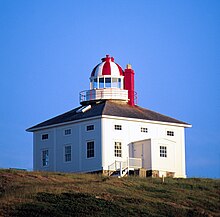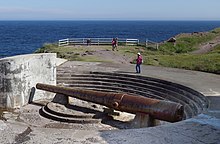Cape Spear
Cape Spear, located on the Avalon Peninsula near St. John's, Newfoundland, is the easternmost point in Canada[1] (52°37'W), and North America, excluding Danish-controlled Greenland.
Cape Spear is within the municipal boundaries of the city of St. John's, located about 2 miles (3.2 km) from Blackhead, an amalgamated area of St. John's.
The Portuguese named this location "Cabo da Esperança" which means "cape of hope", which became "Cap d'Espoir" in French and finally "Cape Spear".
Cape Spear is the trailhead/trail end for two components of the East Coast Trail.
Contents
Cape Spear Lighthouse National Historic Site[edit]

The 1836 lighthouse
|
|
| Location | Cape Spear St. John's, Newfoundland and Labrador Canada |
|---|---|
| Coordinates | 47°31′12.1″N 52°37′25.0″W / 47.520028°N 52.623611°W |
| Year first constructed | 1836 (first) |
| Year first lit | 1955 (current) |
| Construction | limestone tower (first) concrete tower (current) |
| Tower shape | octagonal tower with balcony and lantern rising from the square roof of the keeper’s house (first) octagonal tower with balcony and lantern (current) |
| Markings / pattern | white tower and lantern, dome with red and white stripes (first) white tower and lantern, red balcony rail (current) |
| Height | 11 metres (36 ft) (first) 13.7 metres (45 ft) (current) |
| Focal height | 71 metres (233 ft) |
| Range | 20 nautical miles (37 km; 23 mi) |
| Characteristic | Fl (3) W 15s. |
| Admiralty number | H0454 |
| CHS number | CCG 507 |
| NGA number | 1868 |
| ARLHS number | CAN-748 (first) CAN-148 (current) |
| Managing agent | Parks Canada [2] |
History[edit]
The Cape Spear region was originally inhabited by Beothuk peoples.[3] Additionally, Mi’kmaq communities practiced a non-sedentary presence in the area,[3][4] harvesting subsistence resources on a temporary basis prior to permanent residency at settlements such as St. George’s Bay and Conne River from the nineteenth century onwards.[4] In contrast to European settlers who viewed the cape as a place of significance as the easternmost point in Canada, there is no known archaeological evidence to indicate that Cape Spear was viewed by local Indigenous communities as a place of symbolic geographical importance.[3] According to Fife and Roseman, historically there are “no indications that either the Beothuk or the Mi’kmaq equated Cape Spear with a ‘land’s end’ that was meaningful to them.”[3]
A lighthouse has operated at Cape Spear since September 1836. The original Cape Spear lighthouse was the second lighthouse built in Newfoundland; the first was built in 1810 at Fort Amherst, at the entrance to St. John's Harbour. In 1832, the first legislative assembly for the colony created a lighthouse board. Cape Spear was chosen as the site for a new lighthouse because it was on the rocky eastern coast near the entrance to St John's harbor.
Nicholas Croke and William Parker, two St. John's builders, won the contract for the lighthouse and work began in 1834 or early in 1835.[5] The first lighthouse was a square wooden building with a tower in the middle containing the light. A foghorn was added in 1878. The first light used at Cape Spear had already been used since 1815 at a lighthouse at Inchkeith on the east coast of Scotland. This light used seven Argand burners and curved reflectors. This was later replaced by a dioptric lens system; the light was first lit by oil, then acetylene, and finally electricity in 1930.
Because of its proximity to convoy routes during the Second World War, a Canadian-manned gun battery including two Lend-Lease ex-US 10-inch M1888 guns on disappearing carriages was installed at Cape Spear to defend the entrance to St. John's harbor. Barracks and underground passages leading to the bunkers were built for the use of troops stationed there. The gun barrels remain in place.[6][7]
Current[edit]
A new concrete building was built to house the light in 1955. The lighthouse is the oldest surviving lighthouse in Newfoundland and the location has been designated a National Historic Site of Canada.[8] The original lighthouse building and the light keeper's residence have since been restored to the period of 1839, and are open to the public. The visitor centre includes a gift shop. The lighthouse was designated under the federal Heritage Lighthouse Protection Act in June 2016.[9]
The World War II bunkers and gun barrels that are located at the site afford a sheltered view of the ocean.
Some visitors attracted by the scenery and history have been swept away by the large and unpredictable waves at Cape Spear, prompting Parks Canada to post numerous warning signs in the area.
Keepers[edit]
In 1835, dense fog enveloped an approaching warship carrying a VIP visitor to St. Johns. The Governor sent out several pilot boats, and a young harbour pilot names James Cantwell succeeded in locating the ship and guiding it safely into harbour. Asked what reward he would like, he requested the job of keeper at the Cape Spear lighthouse, then under construction. It had been promised to another man, Emmanuel Warre, but when Warre died ten years later James Cantwell became the second keeper. He served for 35 years; his son Dennis, who had been his assistant, later took over and, with two short intermissions, the Cantwell family kept the Cape Spear light for over 150 years.[10]
List of keepers:
- Emanuel Warre 1836–1846
- James Cantwell 1846–1879
- Austin Sheppard 1880-1886
- Dennis Cantwell 1886-1909
- James Cantwell 1909-1918
- William Cantwell 1918–1925
- Jack Cantwell 1925–1939
- Weston Cantwell 1939–1944
- Frank Cantwell 1944–1965
- Martin Hefferan 1965–1982
- Gerald Cantwell 1982–1997 [11]
See also[edit]
Further reading[edit]
- Environment Canada – Parks, Cape Spear National Historic Park brochure, 1986.
References[edit]
- ^ The Canadian Encyclopedia — Cape Spear
- ^ Rowlett, Russ. "Lighthouses of Southeast Newfoundland". The Lighthouse Directory. University of North Carolina at Chapel Hill. Retrieved December 30, 2015.
- ^ a b c d Fife, Wayne; Roseman, Sharon R. “Where North America Ends,” The Tourism Imaginary and Pilgrimages to the Edges of the World. Tourism and Cultural Change, vol. 44. Channel View Publications, 2015. Web. p.143-144. Retrieved from Google Books; March 12, 2017. ISBN 9781845415235
- ^ a b Martijn, Charles A. "Early Mikmaq Presence in Southern Newfoundland: An Ethnohistorical Perspective, c.1500-1763." Vol. 19, No 1: The New Early Modern Newfoundland: Part 2, Newfoundland and Labrador Studies. St. John's, Newfoundland: Memorial University, 2003. Web. n. pag. Retrieved March 12, 2017. ISSN: 1715-1430
- ^ "Cape Spear Lighthouse National Historic Site of Canada". Parks Canada. Retrieved 26 June 2014.
- ^ Berhow, Mark A., Ed. (2015). American Seacoast Defenses, A Reference Guide, Third Edition. McLean, Virginia: CDSG Press. p. 225. ISBN 978-0-9748167-3-9.
- ^ US coast defences in Newfoundland at the Coast Defense Study Group website
- ^ Cape Spear Lighthouse. Canadian Register of Historic Places. Retrieved 1 July 2012.
- ^ "Cape Spear Lighthouse Receives Heritage Lighthouse Designation". News, Government of Canada. Government of Canada. 30 June 2016. Retrieved 29 March 2017.
Cape Spear Lighthouse is one of 76 lighthouses from across Canada to be designated since the Act was adopted in 2008, with more designations to come.
- ^ Molloy, David (1994). The First Landfall - Historic Lighthouses of Newfoundland and Labrador. Breakwater. p. 53. ISBN 1550810960.
- ^ Cape Spear Lighthouse Archived March 4, 2016, at the Wayback Machine. Lighthouse Friends
External links[edit]
| Wikimedia Commons has media related to Cape Spear. |
- Parks Canada site
- Aids to Navigation Canadian Coast Guard
Coordinates: 47°31′25″N 52°37′10″W / 47.52361°N 52.61944°W


